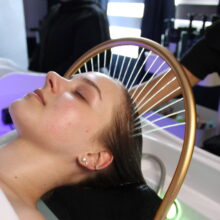Float Tanks 101: Feeling Like a Baby in Outer Space
- Published: Tuesday, March 19th 2013
- in Living Well
By Jay Friedman
 Image Courtesy of float | seattle
Image Courtesy of float | seattle
“A spa is a place for pampering, whereas a float tank gives you an experience,” explains Sean McCormick, owner of Floasis Float Center in Seattle. I love to be pampered, but I’m always open to a new experience, especially one that McCormick describes as “the ultimate tool to get to know yourself better in a brand-new way.”
Welcome to the world of floating.
While a spa has staff to dote on you, at a float center, it’s just you and the tank. A worker will orient you, of course, but when that person leaves, you’re on your own. So what do you do?
Undress and take a shower, covering any cuts with balm. You’ll want to be naked in the floatation tank, as it’s private, and clothes cling and become distracting. Remove contact lenses. Place in your earplugs. Perhaps most important, turn off any communication devices.
Now you’re ready to float. At Floasis, I try its two types of tanks. One is like a coffin you slide into, while the other is a taller space that you can more easily enter. In either, you’ll find yourself in a fairly shallow pool of water packed with so much Epsom salt that it’s more buoyant than sea water. The water temperature is 93.4°, equal to the outside of the skin, so it’s immediately warm and comforting.
Before completely submitting myself, I locate and open the tank door so that I’ll be familiar with the process at the end of my hour, in case I’m disoriented. During my first float, I use the dimmer switch to leave the lights slightly on, and bring a towel to the tank door so I can leave it wedged open for additional light control.
As a non-swimmer, I feel tense about letting go. “Breathe,” I beckon, noting that there’s plenty of air, then remind myself, “Trust the Epsom. Trust the Epsom. Trust the Epsom.” As I lie back, I notice that my legs and torso aren’t touching the floor of the tank. The water is supporting me. This thing works!
I want to float, so with my head on the water, I slowly release the tension in my neck. For the first time in my life, my ears are below the surface. Sound dulled, I actually crave more sensory deprivation and seek darkness.
I feel freed from stimulation. My muscles stop fighting me, having reached a place of trust. I play with a couple of positions, first with my hands clasped behind my head, but eventually I find I prefer them on my chest or off to my sides. At one point, I experiment and actually try to turn over, but fail—relieved that you can’t accidentally do that and drown, even if you fall asleep.
Far from dangerous, the float tank is a place of safety and security. At times the warmth and quiet make me feel like I’m floating in a protected womb. Other times, my awareness of the lack of gravity sends me to space like an astronaut. Either way, I’m feeling really good.
“Your cortisol levels will plummet, reducing stress, while your dopamine levels will soar, increasing your sense of wellbeing,” McCormick had advised me pre-float. He also ran through a list of the benefits of floating, such as detoxification of the body, relief of stress and chronic pain, smooth skin from the salt, and much more, but all I am feeling is…
Immense relaxation. And the occasional lull of sleep.
After an hour, music plays to announce that the float session is coming to a close. My advice if you try this? Get up slowly, making your way, when ready, to the shower to remove all of the salt. Don’t get any in your eyes! And hopefully don’t be in a rush to go out to the real world. Drink lots of water and relax if you can after the experience. As rejuvenating as I find my time in a float tank to be, it’s like a drug that has me a little trippy and a lot happy afterward. And full of inner peace for deep sleep when night falls—likely dreaming of floating away.
You might also like:
Reflexology 101: Not Just a Foot Massage
Spa 101: Introduction to Shirodhara
Salty Healing: Salt Therapy 101
Vinotherapy 101
Hammams 101
Jay Friedman is a Seattle-based freelance food and travel writer who happens to tour extensively as a sex educator. He sees sensuality in all aspects of life, and blogs about it at his Gastrolust website. You can follow him on Twitter @jayfriedman.


